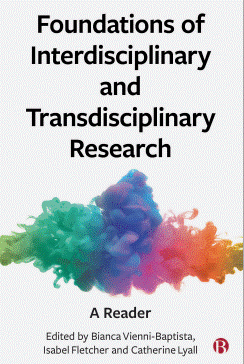Why Interdisciplinary And Transdisciplinary Approaches Matter

Table of Contents
Enhanced Problem-Solving Capabilities through Interdisciplinary and Transdisciplinary Approaches
Successfully tackling complex issues necessitates a move beyond single-discipline perspectives. Interdisciplinary and transdisciplinary approaches offer enhanced problem-solving capabilities by fostering collaboration and providing a holistic understanding.
Breaking Down Silos and Fostering Collaboration
These approaches encourage collaboration between experts from different disciplines, breaking down traditional barriers and fostering a synergistic environment. This cross-pollination of ideas and perspectives leads to more comprehensive and innovative solutions.
- Successful Projects: The success of interdisciplinary and transdisciplinary approaches is evident in various fields. Climate change research, for example, requires input from climatologists, economists, sociologists, and policymakers to develop effective mitigation and adaptation strategies. Similarly, public health initiatives benefit from collaborations between epidemiologists, medical professionals, public health officials, and community leaders. Urban planning projects increasingly involve architects, engineers, sociologists, and urban planners to create sustainable and livable cities.
- Advantages of Diverse Perspectives: Diverse perspectives are crucial. A team comprising individuals with different backgrounds, expertise, and ways of thinking can identify solutions that might be missed by a homogenous group. This diversity in skill sets and approaches fosters creative problem-solving and robust solutions.
Holistic Understanding of Complex Issues
A purely disciplinary approach often overlooks critical aspects of a complex problem. Interdisciplinary and transdisciplinary approaches provide a much more holistic and nuanced understanding by considering multiple perspectives and interconnected factors.
- Limitations of Single-Discipline Approaches: Consider a study on the impact of a new dam. A purely engineering approach might focus solely on structural integrity and water management. However, an interdisciplinary approach would also consider the social, economic, and environmental impacts on local communities, biodiversity, and downstream ecosystems.
- Effectiveness of Integrated Approaches: Integrated approaches lead to more effective solutions. By considering all relevant factors, potential unintended consequences can be identified and mitigated, leading to more sustainable and equitable outcomes.
Innovation and Creativity through Interdisciplinary and Transdisciplinary Collaboration
The interaction of different disciplines fosters innovation and creativity, leading to the development of new ideas, methods, and solutions.
The Birth of New Ideas and Methods
The synergy between disciplines fuels the creation of novel solutions. The cross-pollination of ideas and methodologies from different fields sparks new perspectives and approaches that would be unlikely to emerge within a single discipline.
- Innovative Solutions: Many technological advancements have emerged from interdisciplinary collaborations. Biomedical engineering, for example, combines principles of biology, medicine, and engineering to develop innovative medical devices and treatments. Similarly, advancements in artificial intelligence often result from collaborations between computer scientists, mathematicians, and cognitive scientists.
- The Cross-Pollination Effect: The cross-pollination of ideas is key. Concepts from one field can inspire new methodologies in another, leading to breakthroughs that would not have been possible otherwise.
Developing More Creative and Effective Solutions
Diverse perspectives and skill sets are essential for developing more robust and creative solutions. These approaches encourage different thinking styles, leading to more comprehensive and innovative outcomes.
- Importance of Diverse Thinking Styles: Different disciplines have different ways of approaching problems. Combining these diverse thinking styles generates more creative solutions and enhances the quality of decision-making.
- Robust Solutions from Diverse Teams: Research consistently demonstrates that diverse teams tend to produce more innovative and effective solutions. This stems from the ability to challenge assumptions, consider multiple viewpoints, and identify blind spots.
Improved Communication and Knowledge Transfer in Interdisciplinary and Transdisciplinary Settings
Effective communication and knowledge transfer are essential for successful interdisciplinary and transdisciplinary collaborations.
Bridging the Gap Between Disciplines
Communication challenges can arise due to different terminologies, methodologies, and ways of thinking. Overcoming these challenges requires deliberate effort.
- Strategies for Effective Communication: Strategies to improve communication include the development of a shared vocabulary, the use of visual aids to explain complex concepts, and the utilization of collaborative platforms to facilitate knowledge sharing. The use of facilitators or translators can also bridge the communication gap between disciplines.
- The Role of Translators/Facilitators: In complex projects, translators or facilitators can play a vital role in ensuring smooth communication and knowledge transfer between disciplines.
Creating a Shared Understanding
These approaches facilitate the creation of a shared understanding and common ground among researchers and practitioners from different fields.
- Shared Goals and Objectives: Clearly defined shared goals and objectives are crucial. These shared aims create a sense of unity and purpose, fostering collaboration and shared commitment.
- Building Trust and Rapport: Building trust and rapport among team members from diverse backgrounds is essential for successful collaboration. This requires open communication, mutual respect, and a willingness to understand different perspectives.
Conclusion
Adopting interdisciplinary and transdisciplinary approaches offers significant advantages. They enhance problem-solving capabilities by fostering collaboration and providing holistic understanding, stimulate innovation through the cross-pollination of ideas, and improve communication across disciplines. To address the complex challenges facing our world, we must embrace these collaborative models.
Call to Action: Actively seek opportunities for interdisciplinary and transdisciplinary collaboration in your field. By embracing these approaches, you contribute to the development of more innovative and effective solutions. Explore resources such as university programs and research initiatives focused on interdisciplinary studies. Let's work together to build a brighter future by utilizing the full potential of these powerful methodologies. The success of tomorrow relies on our ability to transcend traditional disciplinary boundaries and embrace the power of collaborative, integrated approaches.

Featured Posts
-
 Ufc Vegas 106 Michael Morales Secures Second Consecutive Bonus
May 19, 2025
Ufc Vegas 106 Michael Morales Secures Second Consecutive Bonus
May 19, 2025 -
 The Eus Squeeze The Impact On European Citizens
May 19, 2025
The Eus Squeeze The Impact On European Citizens
May 19, 2025 -
 Coach Mike Youngs Next Moves A Look At Virginia Tech Basketballs Future
May 19, 2025
Coach Mike Youngs Next Moves A Look At Virginia Tech Basketballs Future
May 19, 2025 -
 La Opinion De Alfonso Arus Sobre Melody Y Su Candidatura A Eurovision 2025 En Arusero
May 19, 2025
La Opinion De Alfonso Arus Sobre Melody Y Su Candidatura A Eurovision 2025 En Arusero
May 19, 2025 -
 Is Jamala Performing At Eurovision 2025
May 19, 2025
Is Jamala Performing At Eurovision 2025
May 19, 2025
